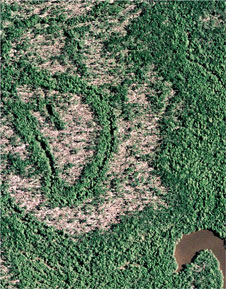Hurricane Katrina released large amounts of carbon by destroying 320 million trees
Hurricane Katrina released large amounts of carbon by destroying 320m trees
mongabay.com
November 15, 2007
The destruction of 320 million large trees by Hurricane Katrina reduced the capacity of forests in the Southern United States to soak up carbon, reports a new study published in the journal Science. The research shows that hurricanes and other natural disturbances “can affect a landscape’s potential as a ‘carbon sink’ because the dead vegetation then decays, returning carbon to
the atmosphere, and because the old vegetation is replaced by smaller, younger plants.”
 Damaged forests in the Pearl River Basin along the Louisiana-Mississippi border were photographed from the air in late 2005. Resistant cypress and tupelo trees surround downed and dead hardwood forest trees such as oak, sweetgum and maple. Credit: Louisiana State University Hurricane Katrina & Rita Cooperative Clearinghouse |
Tulane University biologist Jeffrey Q. Chambers and colleagues measured Hurricane Katrina’s carbon impact by analyzing satellite images taken before and after the storm to look for changes in green vegetation, wood, surface litter, and other materials. Chambers says that global warming may increase the frequency and intensity of such events, triggering a positive carbon feedback cycle through higher tree mortality.
“The loss of so many trees will cause these forests to be a net source of carbon dioxide to the atmosphere for years to come,” said Chambers. “If, as many believe, a warming climate causes a rise in the intensity of extreme events like Hurricane Katrina, we’re likely to see an increase in tree mortality, resulting in an elevated release of carbon by impacted forest ecosystems.”
“The carbon cycle is intimately linked to just about everything we do, from energy use to food and timber production and consumption,” he continued. “As more and more carbon is released to the atmosphere by human activities, the climate warms, triggering an intensification of the global water cycle that produces more powerful storms, leading to destruction of more trees, which then act to amplify climate warming.”
Overall, the loss of 320 million large trees totaled 105 teragrams of carbon, representing 50 to 140 percent of the net annual U.S. forest tree carbon sink
CITATION: Chambers, J.Q. (2007). Hurricane Katrina’s Carbon Footprint on U.S. Gulf Coast Forests. SCIENCE NOVEMBER 16, 2007